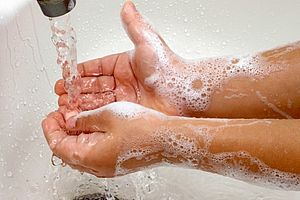Antimicrobials - Extreme Clean Isn’t Green

Antibacterial soaps are no more effective at killing bacteria than regular soaps yet they pose environmental risks.(Photo credit Bing.com)
The presence of pharmaceuticals and other “new generation” contaminants in surface waters of the United States has been well documented. In Lake Champlain, for example, researchers have found caffeine, HHCB (a musk fragrance), metolachlor (an herbicide). Effects are not well known and likely to vary as much as the contaminants themselves do. Among the most worrisome groups of new-generation contaminants are antimicrobials. The widespread use of antimicrobial soaps and detergents has led to the spread of “super-germs”, resistant to many of our medications.
Antimicrobials have become ubiquitous. In a study of 2,517 people age six or older, nearly 75% had the antimicrobial chemical triclosan in their urine. Triclosan was found in over 50% of water samples tested by the US Geologic Service throughout the United State while an additional seven antibiotics were found in more than 10% of samples. They wash down our sinks and are not always removed at wastewater treatment facilities.
In the 1990s there were only a few antimicrobial products available for sale. Within a decade, over 700 different products could be purchased. Originally, antimicrobials were used in hospitals and other places where vulnerable populations needed to be protected. However, thanks to aggressive marketing by producers of the chemicals, global sales of antimicrobial personal care products reached $350-400 million per year as of 2008 and sales are increasing at 3-7% per year. Antimicrobials products include certain liquid hand soaps, deodorant bar soaps, face washes, deodorants, toothpastes and mouthwashes. Some more amusing products include cutting boards, mattresses, socks, and even chopsticks.
Antimicrobials have become widespread in household products, despite an absence of evidence of their effectiveness. A literature review and study undertaken by researchers at the University of Michigan, Tufts, and Columbia found no difference in the number of bacteria on the hands of individuals who washed with antimicrobial soaps compared to those who used plain soaps, and concluded that they were no more effective at preventing infectious disease than plain soaps. Furthermore, antimicrobials do not affect viruses which cause our most common illnesses like the flu.
The Food and Drug Administration, in a review of triclosan found mixed results as to effectiveness. For some products, like toothpaste, “The evidence showed that triclosan … was effective in preventing gingivitis.” However other products did not achieve desired results. “The agency does not have evidence that triclosan in antibacterial soaps and body washes provides any benefit over washing with regular soap and water.”
One concern with antimicrobials is that they may contribute to the rise of antibiotic resistant “super bugs”. The Center for Disease Control describes the rise of antibiotic resistance thusly: “Every time a person takes antibiotics, sensitive bacteria are killed, but resistant germs may be left to grow and multiply. Repeated and improper use of antibiotics is a primary cause of the increase in drug-resistant bacteria.” Presumably, antimicrobial cleaning agents can act in the same way as drugs. So far, development of bacterial resistance from antimicrobial soaps has only been demonstrated in the laboratory.
Antimicrobials differ from cleaners like bleach and alcohol. Bleach and alcohol physically destroy biotic agents by drying them out. The bacteria can no more develop resistance to them than we could develop a genetic resistance to being thrown in a fire or drowned. On the other hand, antimicrobials interfere with the bacteria’s cellular processes. Therefore mutations in the bacteria can lead to alternative processes and the bacteria can develop resistance.
Recently, researchers in Portugal have shown that migratory birds can carry antibiotic resistant strains of bacteria over long distances.
An additional concern about antimicrobials is that they may promote allergies in children. Stuart Levy of Tufts University notes that, “Reports are mounting about a possible association between infections in early childhood and decreased incidence of allergies.” According to this hypothesis, making households extra clean prevents children from being exposed to low level infections. As a result their immune systems do not get enough “exercise”. Dirty environments apparently help the normal development of immunity, a comforting thought for all overwhelmed housekeepers.
The use of antimicrobial soaps in households is a purely voluntary exercise whose risks exceed any benefits. There is little evidence that the products help prevent disease in otherwise healthy humans and substantial risk in their overuse and abuse. Levy concluded, “we believe that we can rid ourselves of bacteria when, in fact, we cannot. Instead, we should ‘make peace’ with them. Although we need to control pathogens when they cause disease, we do not have to engage in a full-fledged
